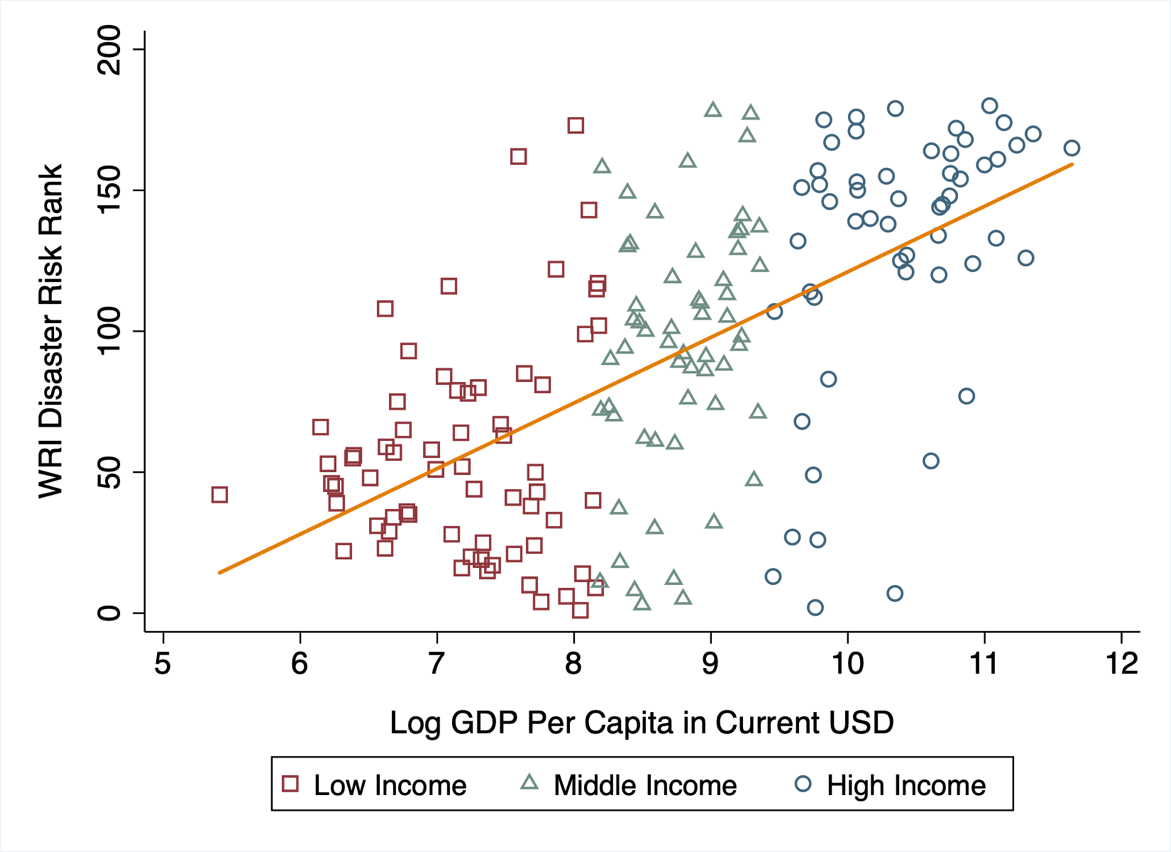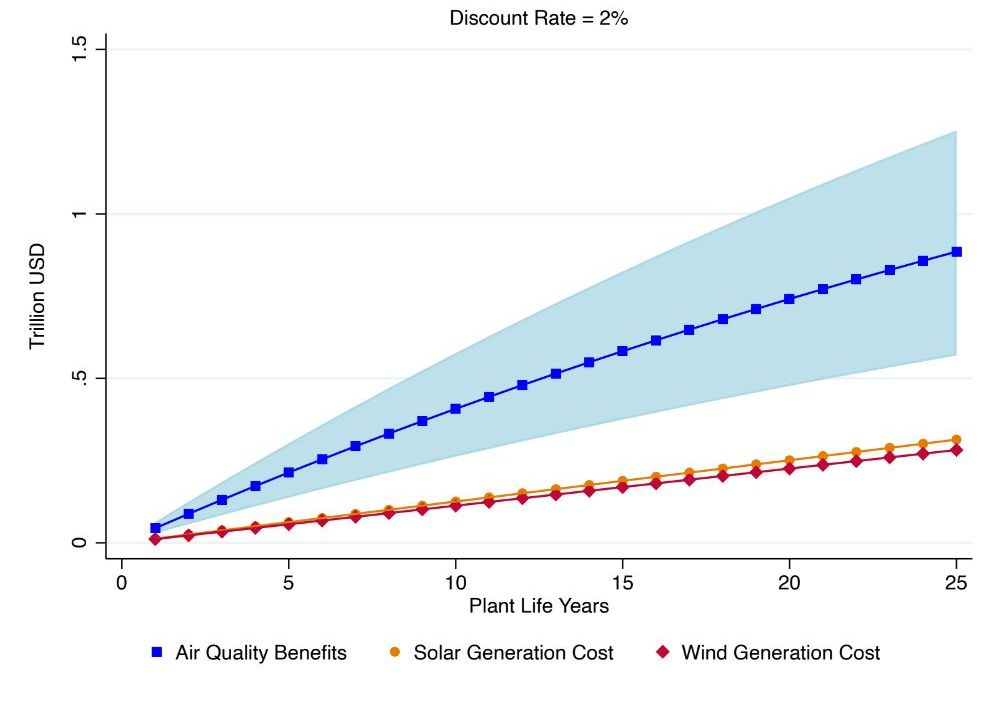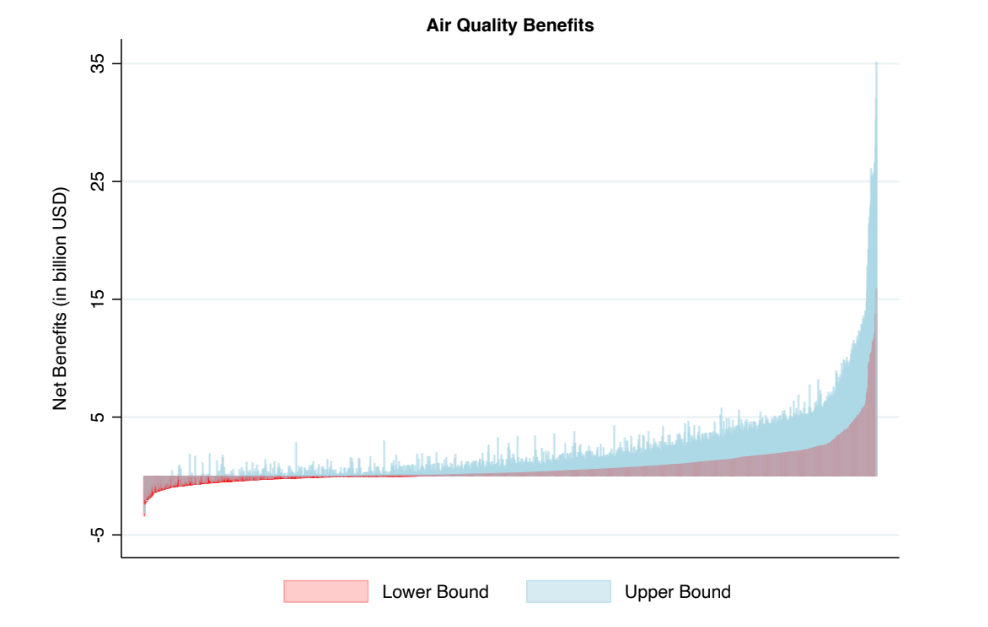Coal-fired power plants are a highly polluting energy source but people are either unaware or unable to convey their dissatisfaction about living with poor air quality. Using survey data from 51 low- and middle-income countries, this article calculates citizens' willingness to pay to phase-out coal power. It measures the wellbeing of residents in close proximity to a power plant, and calculates that the air quality benefits accruing to them would exceed the costs of solar and wind energy generation.
Phasing out coal-fired power and replacing it with less-polluting alternatives, such as wind and solar power, is one of the key forms of climate action that governments around the world could undertake to mitigate climate change and environmental damage. Renewable technologies are now sufficiently scalable to replace much of the capacity generation of coal-fired power plants, and fast-growing R&D investments in energy storage technology are helping address challenges of variable grid demand. Thus, a green energy transition looks technologically more feasible now than ever.
To achieve this using a bottom-up approach, there needs to be pressure from the citizens of coal power-dependent countries. In this spirit, most of the coal power plants in the United States and in Western European countries have been scheduled for retirement. However, coal power generation still commands strong public and private investments in fast-growing nations such as India and China. Coal is a highly polluting energy source with detrimental consequences for both air quality and climate change. But it is still far from obvious that those who reside near coal-fired power plants are aware of its negative consequences. Without citizen awareness, political forces seem less likely to be unleashed to phase out coal-fired power (Besley and Persson 2023).
Much of the prior research on environmental psychology has concentrated on the developed world, primarily the United States and Europe (Whitmarsh 2008, Poortinga et al. 2019). However, climate change damages are predicted to be disproportionately higher in the Global South (Cruz and Rossi-Hansberg 2021). As Figure 1 suggests, low- and middle-income countries face a higher risk of damages caused by disaster events. Moreover, future energy demand is predicted to come largely from the countries that continue to rely heavily on coal to meet their energy needs. There is a need to close this knowledge gap by looking at low- and middle-income countries, something that our work does.
Figure 1. Relationship between GDP per capita and country-level disaster risk

Source: Authors’ representation using United Nations University data
Notes: i) This chart presents a scatterplot of the WRI country-level disaster risk rankings and country-level GDP per capita in 2019. Rankings are in decreasing order – that is, countries with lower ranks are at higher risk of damages caused by disaster events. ii) The ranking considers exposure, vulnerability, susceptibility, coping capability, and adaptive capacity of the overall country. iii) Low-, middle-, and high-income country classification is done by partitioning the countries in three quantiles based on their 2019 GDP per capita numbers as reported in the World Bank national accounts data.
The study
In our work (Besley and Hussain 2023), we investigate whether perceptions of air quality are affected by proximity to operational coal-fired power stations. To do this, we make use of global attitudes data on ambient air quality perceptions from the Gallup World Poll, a nationally representative annual survey covering 99% of the world's adult population living in more than 160 countries. We focus on measuring local effects by exploiting spatial granularity at the geocode level (that is, the latitudes and longitudes of survey respondents) to identify whether respondents are located within a 40 kilometre radius of a coal power plant. The main analysis is representative of 51 countries, including India, Indonesia, Brazil, which are mostly low- and middle-income countries.
We use these findings to construct a measure of the willingness to pay for closing existing coal-fired power plants in all the countries. To do so, we look at the life satisfaction approach (following earlier work by Layard et al. (2008) and Kahneman and Deaton (2010)). This exploits the negative relationship between air quality dissatisfaction and life satisfaction, along with the positive relationship between income and life satisfaction, to get an ‘income equivalent’ for air quality dissatisfaction. We use these numbers to estimate the net benefits of transitioning towards solar and wind generation on the global scale. Considering the resulting air quality improvements, we find that the benefits are large enough to justify investing in a green transition that involves closing coal-fired power stations.
Domestic and international policies to reduce carbon emissions are only likely to happen in democracies if citizens demand change. Hence, it is crucial to know about the factors that drive citizens’ perceptions of their local environment. Our finding that there is a positive relationship between being located near a coal-fired power station dissatisfaction with ambient air quality. It is important because it suggests a latent demand for change.
Estimating willingness to pay for clean air and green energy
Although scientific evidence has supported concerns about the detrimental effects of coal power, there are people who benefit from the status quo through employment opportunities both directly in the plants and indirectly in coal mining and associated activities, support for local public amenities maintenance, etc. Shutting down coal plants or replacing them with renewable energy sources would have distributional consequences – an important topic for further research.
Looking at perceptions of air quality, we can gain some insight into how people value air quality and hence what the implicit willingness to pay would be for moving away from coal-fired power. Of course, this does not mean that people will pay in practice, but we can still calibrate how these perceptions of air quality affect wellbeing, and hence how it compares to the effect of income on wellbeing.
Using the quantitative relationship between the wellbeing indicator (which is measured on a 10-step Cantril ladder1 and income and air quality dissatisfaction, we estimate the equivalent variation in life satisfaction of moving residents’ dwelling within the 40-kilometre distance band of coal-fired power plants, to areas outside that band with better air quality. We use this to see whether transition from coal power to green energy is feasible, given the benefits and the costs. We suggest a policy experiment that entails phasing out coal-fired power at a constant rate of 4% per year and replacing this freed capacity with solar or wind generation over a period of 25 years. We calculate the immediate benefits that the exposed population derive from an improvement in their ambient air quality due to lower pollution. We also calculate the costs of solar and wind energy generation by multiplying the respective source-specific global average LCOE values2 in USD/kWh with the total ‘excess’ energy demand because of closing of coal plants. As shown in Figure 2, the transition looks feasible even if we take a very cautious view on the estimates of benefits that come from air quality enhancements due to closing of coal power plants.
Figure 2. Cost-benefit analysis of air quality improvements

Notes: i) Chart shows the cost-benefit results for all 51 countries combined. ii) The blue line represents point estimates of air quality benefits with the shaded area showing upper and lower bounds on the estimates. iii) All the costs and benefits are expressed in present-discounted value terms, with the annual discount rate set at 2% per year.
We also looked at the differences in our measure of willingness to pay across education groups. The educated elite group stands out, all other things being equal – their willingness to pay is nearly two to three times that of other education groups. In terms of differences across countries, we estimate that Indians are less concerned on average; the willingness to pay to move to a better air quality satisfaction zone is less than one-tenth of the global average. This is perhaps not surprising given that India is a middle-income country where people care about income more than air quality for achieving greater life satisfaction.
Policy strategies for a green transition
In practice, the decisions that policymakers will have to make to bring about a green transition will involve deciding whether to decommission specific coal-fired power plants. Our analysis allows us to look at a policy strategy of that kind by looking at the benefits of closing specific coal-fired power stations and replacing that freed capacity with an equivalent 50% solar and 50% wind generation. Figure 3 gives the plant-level net benefits for that could be accrued by over 3,500 operational coal-fired power plants across the world in 2019. It gives a good sense of the distribution of benefits and makes it clear that replacing coal plants with solar and wind generation units would be beneficial in almost all cases, even when taking a very cautious view on the estimates of net air quality benefits.
Figure 3. Plant-level net benefits from closing coal-fired power plants

Notes: i) Chart shows the net benefits from closing all the operational coal-fired power in 2019 located across the whole world. ii) The parameter values are taken from the global estimates using all the 51 countries combined. iii) The two shaded regions in both plots represent upper and lower bounds of the benefits' estimates.
Leveraging survey data is an important part of studying the forces that can shape a green transition towards lower carbon energy sources. Whether policy action will take place is moot; citizens may know how dissatisfied they are but be unable to identify and advocate for a solution to their problem. However, our findings do illustrate the power of research using geocoded data and advocacy to inform these important debates.
The authors are grateful to the British Academy for support under the Shared Understandings of a Sustainable Future programme and to Gallup Inc. for granting access to the World Poll data.
Notes:
- The Cantril Ladder is a scale which measures people towards their life and its components (Cantril 1965). Research conducted across countries around the world indicates substantial correlations between the Cantril Scale and income (Deaton 2008).
- The Levelised Cost of Energy (LCOE) value is the minimum price at which energy must be sold for an energy project to break even.
Further Reading
- Besley, T and A Hussain (2023), ‘Global Gains from a Green Energy Transition: Evidence on Coal-Fired Power and Air Quality Dissatisfaction’, CEPR Discussion Paper No. 18046
- Besley, Timothy and Torsten Persson (2023), “The Political Economics of Green Transitions”, The Quarterly Journal of Economics, 138(3): 1863-1906.
- Cruz, J-L and E Rossi-Hansberg (2021), ‘The Economic Geography of Global Warming’, University of Chicago, Becker Friedman Institute for Economics Working Paper No. 2021-130
- Kahneman, Daniel, and Angus Deaton (2010), “High Income Improves Evaluation of Life but Not Emotional Well-Being”, Proceedings of the National Academy of Sciences, 107(38): 16489-16493.
- Layard, Richard, Guy Mayraz and Stephen Nickell (2008), “The Marginal Utility of Income”, Journal of Public Economics, 92(8-9): 1846-1857.
- Poortinga, Wouter, Lorraine Whitmarsh, Linda Steg, Gisela B ̈ohm and Stephen Fisher (2019), “Climate change perceptions and their individual-level determinants: A cross-European analysis”, Global Environmental Change, 55: 25-35.
- Whitmarsh, Lorraine (2008), “Are flood victims more concerned about climate change than other people? The role of direct experience in risk perception and behavioural response”, Journal of Risk Research 11(3): 351-374.




 25 August, 2023
25 August, 2023 





By: Mohammed Eyasin 31 August, 2023
While coal-based thermal power plants are widely recognized as major environmental polluters affecting air and water quality, they remain vital for employment in countries like India. Notably in coal-rich regions like Jharkhand, the sector provides around 300,000 direct jobs and almost a million indirect positions, while also supporting local communities and state finances through taxes and royalties (reference). As India moves away from coal, approximately half of Jharkhand and West Bengal's districts, and about 30% of districts in Odisha and Chhattisgarh, will face substantial repercussions. An unmanaged halt in coal operations could trigger economic decline, converting coal-reliant regions into economically stagnant zones, adversely impacting local communities and residents. The geographic distribution of coal resources plays a pivotal role. While coal is cost-effective for pithead thermal plants, transportation costs make it pricier for loadhead plants. Regrettably, the coal reserves are concentrated in eastern and central India, posing ecological issues. In contrast, renewable sources flourish in the southern and western regions, accentuating the divide between clean energy-embracing states and coal-dependent ones. Consequently, the shift from coal will likely impact Indian Railways sooner than Coal India Limited. Despite the harmful environmental effects of coal, it also provides considerable advantages to society. When coal is extracted, the government receives revenue from companies like Coal India Limited, and the railways, which transport a significant amount of coal, receive crucial financial support. Additionally, it's important to acknowledge that the government earns substantial income from taxes and fees associated with coal mining, and these earnings are among the highest globally(reference). However, the environmental pollution emanating from these power plants can be mitigated through available technologies. Here are some effective solutions: •Using Electrostatic Precipitators (ESP) up to 99.99% efficient curbs PM10 and PM2.5 emissions; opacity meters ensure compliance. •Flue Gas Desulphurization (FGD) equipment can be installed to control Sulphur Dioxide (SOx) emissions. •Using Low NOx Burners and controlled ammonia injection in post-combustion flue gas can efficiently handle NOx emissions. •Creating green belts around plants and abandoned mines with pond ash and topsoil aids CO2 absorption, restoring balance. •Selling fly ash by-product to cement industry; permit mixing and export. •Pond ash for highways, topsoil conservation, mine fill, and eco-bricks. •Implementing recovery and recycling systems for ash pond water can supply non-potable water for various power plant needs. While advocating for a reduction in the operational load of thermal power plants during daylight hours (technical minimum operating at around 55% Plant Load Factor). When solar energy is available, it's essential to maintain functionality during nighttime or when other non-conventional sources are unavailable. Emphasis on diversifying energy sources including pump storage, solar, and wind energy is imperative. However, these alternatives often face delays due to socio-political factors, resulting in longer implementation timelines. Moreover, recent energy crises, such as the Russia-Ukraine conflict, prompted certain European nations like Germany to temporarily reopen coal-based thermal power plants (reference), underscoring the intricate interplay between energy security and environmental considerations. To conclude, recognizing the crucial role of coal-based thermal plants in employment and revenue is vital; however, prioritizing sustainable technologies and alternative energy sources remains essential. Initiatives like floating solar panels and promoting electric vehicles and green hydrogen contribute to an eco-friendly energy landscape, ensuring a harmonious balance between economic progress and environmental stewardship during the energy transition. REFERENCES: - (2023, November 23). Coal transition will impact more than 13 million people in India: Study – Know Details here. https://www.jagranjosh.com/. Retrieved August 30, 2023, from https://www.jagranjosh.com/current-affairs/coal-transition-will-impact-more-than-13-million-people-in-india-study-know-details-here-1637654835-1 (2022, July 8). Germany Reopens Coal Plants Because Of Reduced Russian Energy. www.forbes.com. Retrieved August 30, 2023, from https://www.forbes.com/sites/juliecoleman/2022/07/08/germany-reopens-coal-plants-because-of-reduced-russian-energy/?sh=42f99780 (2020). Future of Coal in India: Smooth Transition or Bumpy Road Ahead? https://www.brookings.edu/books/future-of-coal-in-india-smooth-transition-or-bumpy-road-ahead/